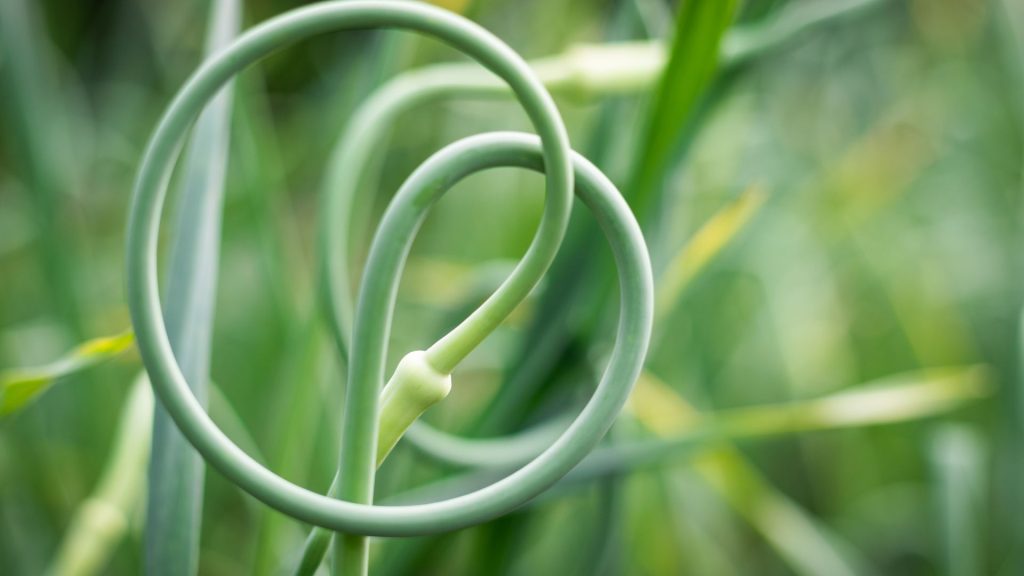Watch It, Dracula … I got your bulbs right here

Sure, you might be one of those people who has had their pumpkins, hay bale and ghosts out in the front yard since the Fourth of July. But as we approach Halloween, now is the time for the real anti-vampire activity — planting garlic.
In the mid- to late-fall when gardeners think about planting, they usually think spring bulbs, and they are right. For early spring bloom in the flower garden, now is the time to plant daffodils, tulips (if you dare-, say the squirrels) crocus and all those other colorful minor bulbs.
Often overlooked is one of the easiest and most delicious vegetables we have … garlic! Mid-to late-October is the time to plant garlic. You say you can’t find it for sale? Well, I have four varieties ready to go with an online class (that is available anytime!). But first, a little more about garlic itself:
First, just what is garlic? Most people would say that it is an herb or a spice, but it is really classified as a vegetable, because it is a member of the onion family (Allium), along with its cousins — shallots, chives, and leeks. The name comes from old English “gar,” meaning spear, and “leek;” so a spear-shaped leek.
Garlic has a long history. It has been used for thousands of years as both a flavoring and as a medicine. Remember, for early settlers, there wasn’t a drug store on every corner, so you grew what medicine you needed.
Garlic is native to Iran and Asia, and records of it being used go as far back as the Egyptians. Over two-thirds of the world’s garlic is produced by China, with India and Korea following. Depending on the statistics you choose, the U.S. is fourth or later on that list. California is home to over 90 percent of the garlic grown in America, with Gilroy, California’s motto being “Garlic Capitol.”
So, if most of the U.S. garlic is grown in Cali, how can I say it’s time for us to plant garlic in the soon to be chilly Midwest?
There are two types of garlic, soft-neck and hard-neck (also called Rocambole). The soft-neck varieties are suited to the warmer climates. And the hard-neck varieties tolerate the cold. Although you might think these names came from the people: We are “hard” because we tolerate the harsh climate, and the warm weather people are “soft” But in reality, it is actually the anatomy of the garlic plant.
When you buy grocery store garlic (low-life quality compared to growing your own), you break the whole garlic called a head of garlic, into the subordinate parts, the cloves. But you don’t see any central hard-stem remnant.
With hard-neck garlic, there is a central leader stem that by harvest time almost has a wood-like quality stem; hence, hard-neck. This central stem also gives those in the Midwest colder regions a bonus. That central leader produces a curly-Q in late May. That is the garlic “scape.” These curly-Qs are harvested in late May, and in high end markets and restaurants, garners a high price.
Garlic is an easy crop. Planted in late October, mulched in November, and then harvested when the 2 first sets of leaves turn brown, which for us can be as early as late May or as late as early August.
Do you want to try your hand at garlic growing this year? I have just what you need. I received my garlic order on the day I was planning on hosting a program about it, so I have converted that program into a “Grab a Garden-to-Go.”
With each registration, you will receive 8 cloves (not heads) of four different types of garlic with educational how-to materials. You will also be given a link to my Will County Master Gardener Power Hour Zoom class, which is recorded, Grow Your Own Garlic. And you can pick up your Garden-to-Go and Grow kit at the Will County Farm Bureau Office.
Registration is $10, and you can register at this link: https://go.illinois.edu/grabandgogarlicclass, or by calling the Will County Extension Office at 815-727-9296. And come early summer, you will have the best garlic you have ever tasted. And speaking of garlic taste, did you know that each variety of garlic has different taste profiles? Some are spicy, some are mellow, and some are even hot. Some varieties have two different characteristics, depending on if you use them fresh (raw) or roasted.
To roast garlic, preheat the oven to 400-degrees and, using the whole head, cut off the top to reveal the cloves. Drizzle with oil of your choice, the wrap in foil and bake for 40 minutes. The consistency of the roasted garlic is paste, and you squeeze out that mellow deliciousness onto toasted bread or in any recipe, really.
The varieties in the garden kits are: Russian Red, Transylvanian, Svea and Bavarian Purple. Russian Red is the long-time reliable favorite for growing in the Midwest. My longtime Master Gardener, Gary Patton, introduced all of the Will County Master Gardeners to growing garlic using Russian Red and, although he has passed, we still honor him by planting a clove in his memory every year.
Transylvanian garlic is one of the earliest to harvest and has a smooth buttery overtone with a spicy finish. Transylvanian garlic is also one of the most cold-hardy. The Svea variety is a purple-streaked, late-season variety that is strong and spicy raw, but takes on a mellow nuttiness when roasted. The fourth variety is Bavarian Purple. It is a mid-season variety with a strong true garlic flavor and excellent in storage.
Join the Midwest garlic-growing community and sign up for my class today!

Garlic is a space-saving crop due to its only vertical growing.